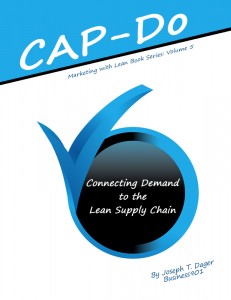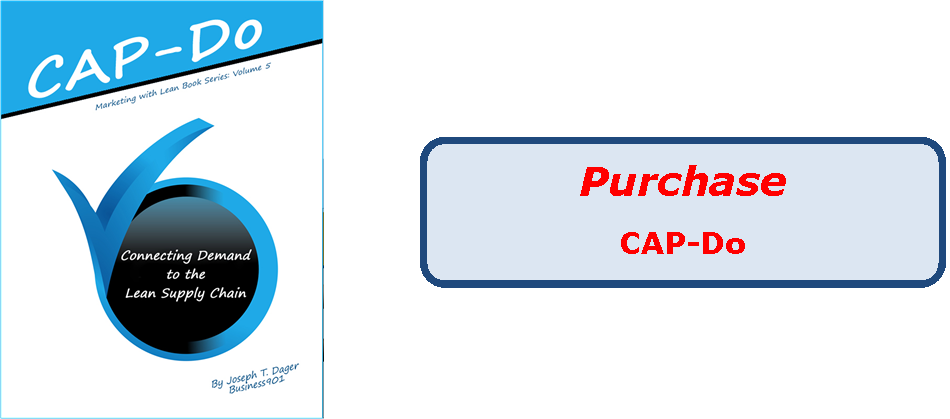CAP-Do: What makes CAP-Do so attractive is that it assumes we do not have the answers. It allows us to create a systematic way to address the problems (pain) or opportunities (gain) from the use of our products and services. CAP-Do is an emergent process. You may know the outcomes that you desire but that is relatively unimportant in today’s world or The Challenger Model. It is the outcomes that your customer requires and how you adapt to his/her processes to produce their needed results. This takes a willingness to discover as you go versus leading the way.  The essence of Pausing or as Peter Senge calls it “Presencing” is the act of acknowledging that there is more than right a answer. We refrained from trying to find answers or problem-solve in the Check and Adjust stage. We can now gather and understand the actions, roles and uses of our product/services. This is the stage where the connection between supply and demand occurs. Most organizations try to choose between what we know (Check) and what we learned (Adjust). The key though is acceptance and understanding or as I have explained earlier; empathy. This empathetic connection is important; not only to our customer, but as an external team we must also empathize with our internal organization. It is this preparation, done with a pause, before we move into the planning stage that is imperative. As we cycle or iterate between the supply and the demand world we will discover complementary answers. The obstacles will get smaller and smaller. The organization that instills the CAP-Do process will put a tremendous amount of faith in the Sales and Marketing teams. These teams must work and overcome the tension between supply and demand. CAP-Do is a Lean process that supports the tenants of Service Dominant Logic and Jobs to be Done. It requires a fundamental understanding of the idea that there is not one single answer in this world for any problem. The answers lie with the people that are addressing the problem at the moment and have a particular job-to-get-done. It is in understanding their needs and their outcomes with greater wisdom. More fundamentally, you create a way to get your own job done in any situation.
The essence of Pausing or as Peter Senge calls it “Presencing” is the act of acknowledging that there is more than right a answer. We refrained from trying to find answers or problem-solve in the Check and Adjust stage. We can now gather and understand the actions, roles and uses of our product/services. This is the stage where the connection between supply and demand occurs. Most organizations try to choose between what we know (Check) and what we learned (Adjust). The key though is acceptance and understanding or as I have explained earlier; empathy. This empathetic connection is important; not only to our customer, but as an external team we must also empathize with our internal organization. It is this preparation, done with a pause, before we move into the planning stage that is imperative. As we cycle or iterate between the supply and the demand world we will discover complementary answers. The obstacles will get smaller and smaller. The organization that instills the CAP-Do process will put a tremendous amount of faith in the Sales and Marketing teams. These teams must work and overcome the tension between supply and demand. CAP-Do is a Lean process that supports the tenants of Service Dominant Logic and Jobs to be Done. It requires a fundamental understanding of the idea that there is not one single answer in this world for any problem. The answers lie with the people that are addressing the problem at the moment and have a particular job-to-get-done. It is in understanding their needs and their outcomes with greater wisdom. More fundamentally, you create a way to get your own job done in any situation.
If you would to purchase CAP- Do, it is available for download as a PDF.

Chapter Outlines:
Check Chapter 1 - Structural Conflicts Chapter 2 - Enterprise Thinking Chapter 3 - A Learning Process, not a Teaching Process Adjust (Act) Chapter 4 - A Perspective of Strength Based Principles Chapter 5 - Lean and the OODA Loop Pause Chapter 6 – Pause Plan Chapter 7 - Lean Sales Methods Chapter 8 - Retool your Sales and Marketing with Lean Do Chapter 9 - Experiment through Prototypes Chapter 10 - Lean Thoughts Chapter 11 - Doing CAP-Do Chapter 12 - CAP-Do Process – Working with SDCA, PDCA, EDCACAP-Do is included in the Marketing with Lean Book Series at no additional cost.


